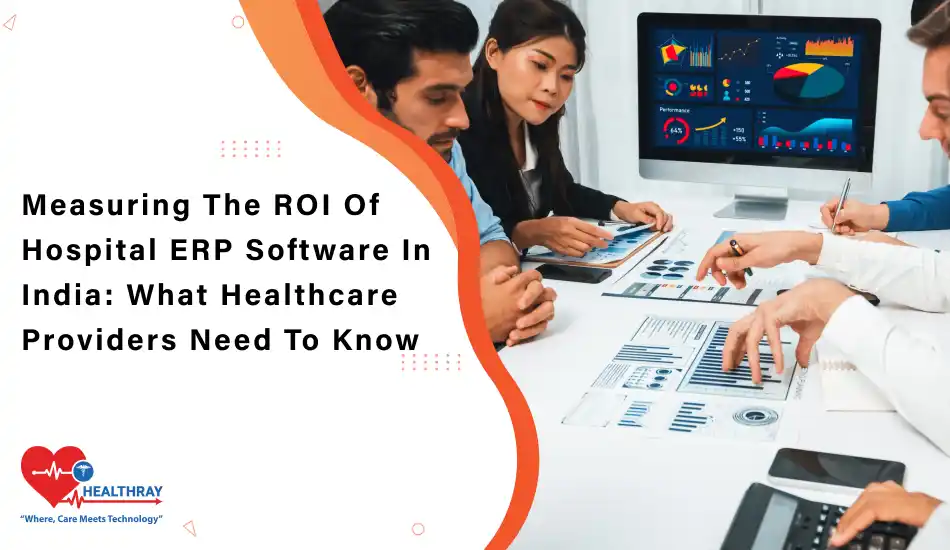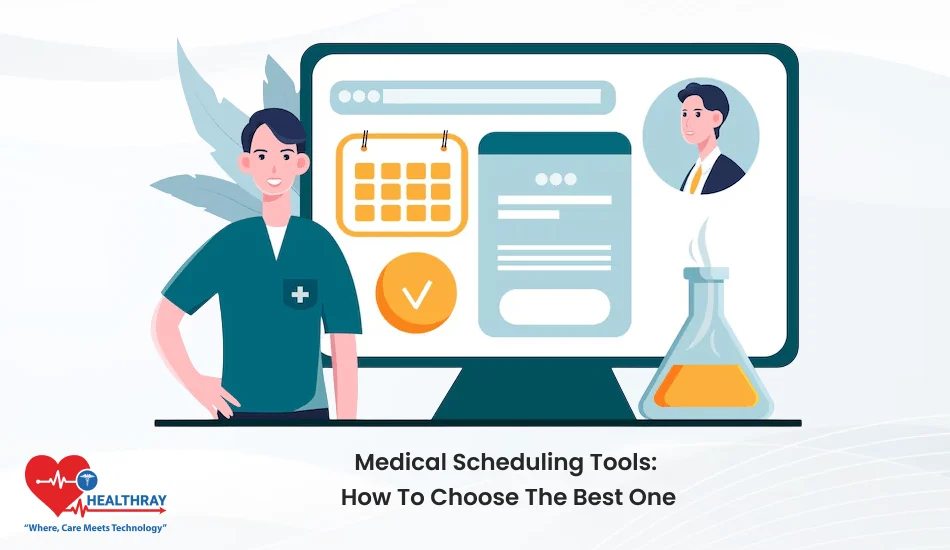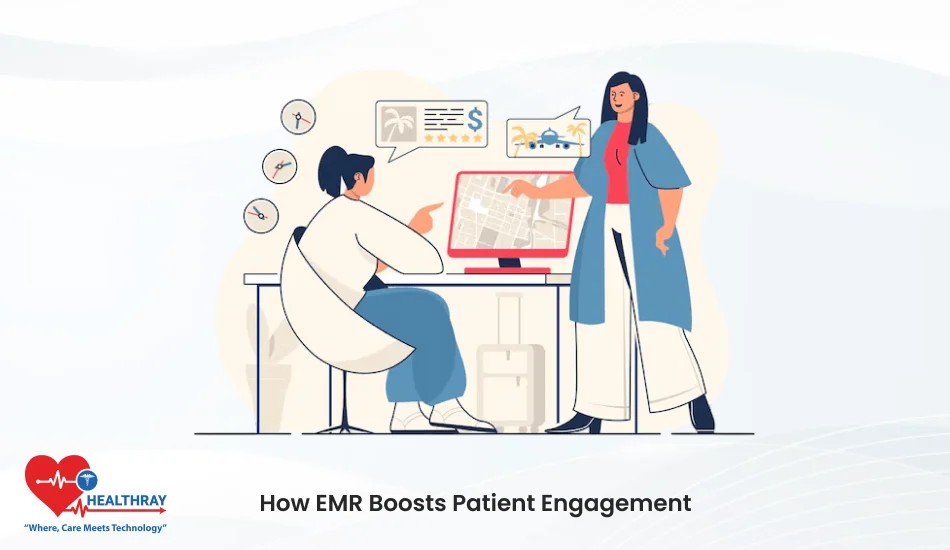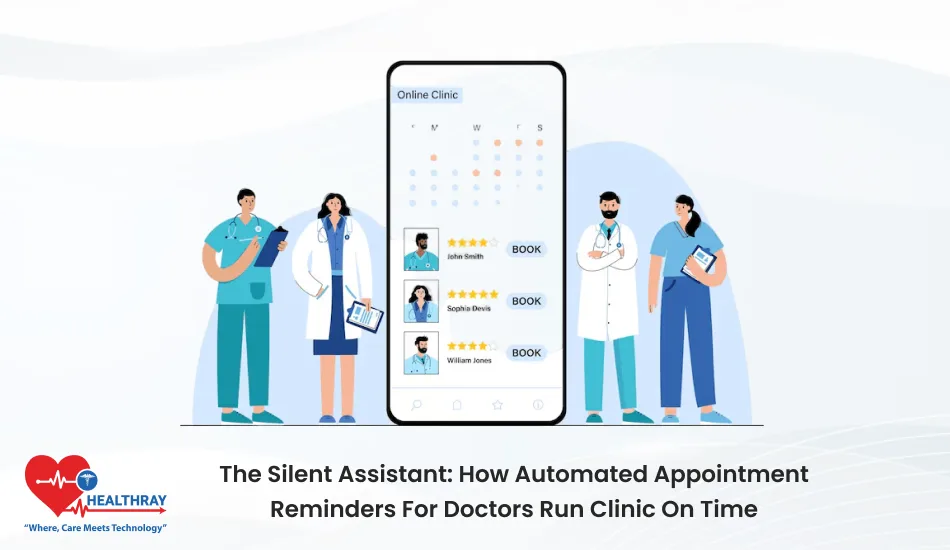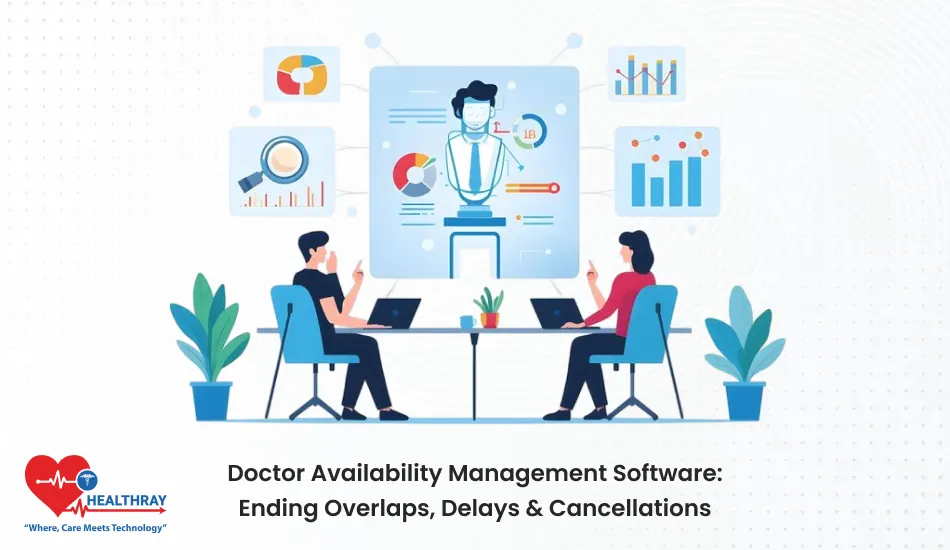Summary
Adopting technology is not particularly difficult in India; you just need to be aware of its true worth. Hospital erp is a major investment. Therefore, if you want to reap immense benefits in financial and operational areas, it is crucial for healthcare providers to understand the ROI of hospital erp software. In essence, ROI shows the amount of money you have made from your ERP software investment, whether it’s direct cost savings, revenue growth, staff productivity, regulatory compliance, or patient satisfaction. In this blog, I will discuss key metrics to evaluate while measuring the ROI of hospital erp software in India. Let’s begin!!!
Introduction
In the modern world of rapid change, hospitals are quickly embracing digital transformation. Furthermore, ERP software has become an essential tool that integrates multiple functions like patient management, billing, inventory, and compliance into a single platform. The major challenge of healthcare sectors is not just adopting technologies but also understanding their real values.
Furthermore, Hospital ERP is a major investment; therefore, it is essential to measure ROI. In addition, this will help you analyze how much improvement has been done in areas like cost savings, efficiency, and patient satisfaction. I am working as a healthcare IT specialist in India. When I first implemented hospital management software, my employees recognized it as merely a technological advancement.
However, after a few months, billing errors got reduced by 60%, inventory wastage got minimized and also there were significant improvements in patients’ satisfaction. Furthermore, When my healthcare management team calculated ROI, we realised ,erp software has not only saved money but also transformed the entire workflows of hospitals. Plus, with ROI analysis, hospitals can establish a clear link in their operational and financial goals. Furthermore, if hospitals become capable of measuring ROI, then they can smartly use their resources to achieve long-term growth and patient care.
Key Benefits and Metrics for Measuring ROI in Hospital ERPs
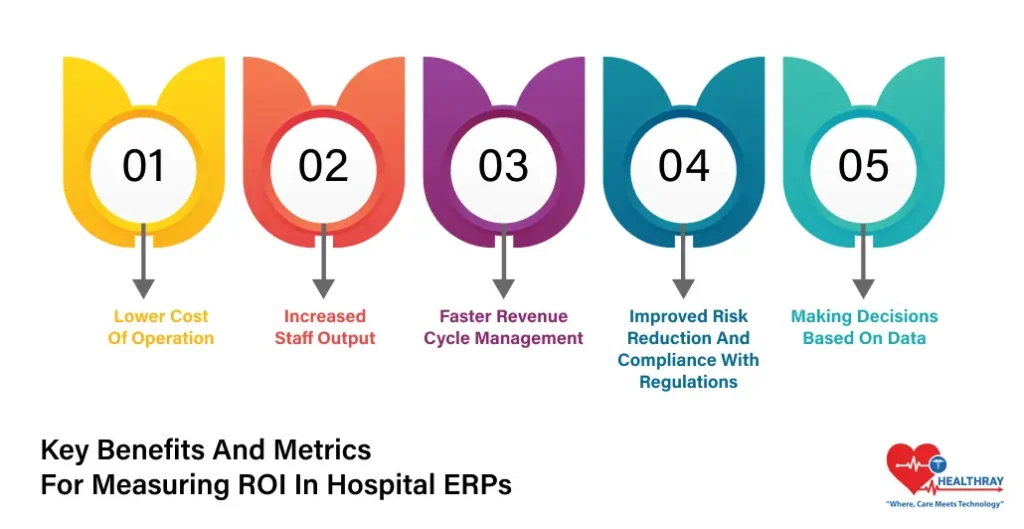
Let’s check out:
Lower Cost of Operation
The biggest benefit of hospital erp software is operational cost reduction. Furthermore, when procurement, inventory management, billing and HR like processes integrate into a single system, the duplication and waste get minimized.
Also, it reduces manual repetitive work. By automating routine tasks, hospitals can minimize administrative load. Additionally, Hospitals can also proactively manage their costs with real-time visibility.
Overall, with a hospital management system, you can:
- Streamlined procurement reducing wasteful spending.
- Eliminated paperwork and manual process errors
- Real-time analytics identifying inefficiencies and cost drivers.
Increased Staff Output
Do your employees mostly handle administrative and paperwork tasks by hand? With hospital erp software, you can simplify these problems. Further, with erp solutions , you can automate repetitive tasks; this way doctors and nurses can put their focus on patient care.
Furthermore, by automating workflows, different departments can collaborate better. Also, it simplifies scheduling and carefully manages the hospital resources.
Key productivity gains include:
- Automated scheduling and billing processes
- Unified access to patient and operational data
- Optimized staffing and reduced overtime costs
Faster Revenue Cycle Management
Do your hospitals face challenges with receiving delayed payments and reimbursement? Fortunately, you can resolve this issue with modern erp software; you can easily resolve this problem. Further, you can easily automate billing, claims submission, and denial management.
Erp software expedites the process and minimizes the error in the system. Overall, clinical erp software accelerates the reimbursement process, improves cash flow and keeps the financial health of the hospital strong and reliable.
Benefits include:
- Automated claims processing with error checking
- Reduced billing errors and fewer payment denials
- Real-time financial reporting improving cash flow management
Step towards digital era with our healthcare solution
Revamp your hospital facilities and embrace change for better healthcare management. Ease in managing and organizing large medical datasets leads to effective analysis. Seize the opportunity now!
Improved Risk Reduction and Compliance with Regulations
In the hospital industry, regulations are very rigid and stringent. Right? In these stressful scenarios, erp software can be your best partner. Furthermore, digital erp software automates policy enforcement, maintains audit trails and also keeps the sensitive patient data harmless and threat-free.
Further, this not only simplifies the compliance but also minimizes the risks of breach and regulatory penalties. Overall, it maintains trust and also provides peace of mind to medical staff members.
Compliance boosts include:
- Automated regulatory checks and alerts
- Secure data encryption and controlled access
- Early identification of billing or operational anomalies
Making Decisions Based on Data
Is your hospital’s decision still based on guesswork? Erp software integrated dashboards and data analysis tools provide you real-time information on clinical, operational and financial metrics.
Further, this complete visibility empowers hospital management software companies to take proactive decisions and make better strategies for their future developments. Overall, with a hospital management system, you can take tangible actions that bring fruitful outcomes and improve your clinic’s performance.
Features include:
- Real-time KPI dashboards for hospital-wide visibility
- Predictive analytics for staffing, inventory, and care needs
- Consolidated financial and clinical reporting for long-term planning
Calculating ROI: Factors and Methodology
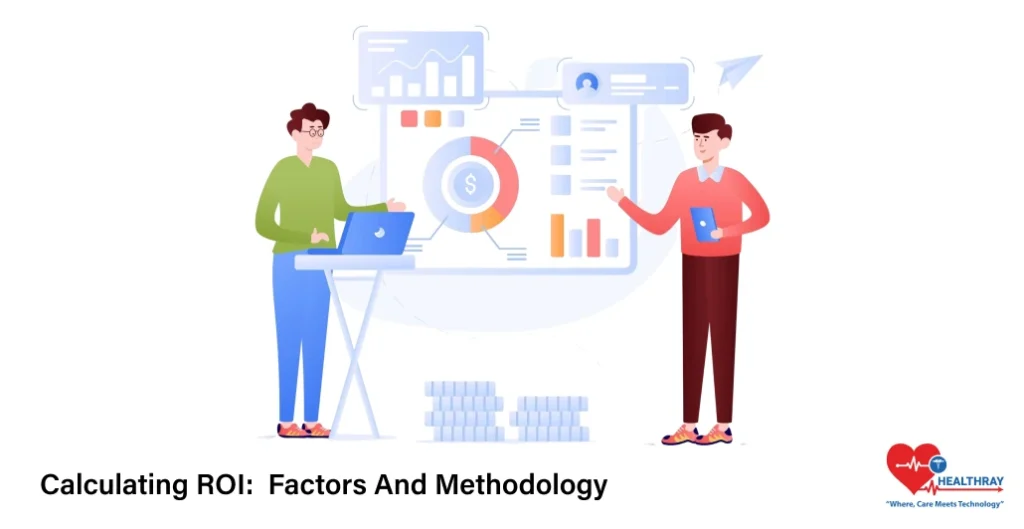
Calculating ROI of hospital erp software is a systematic process. Furthermore, this is not just a game of numbers; instead, it’s a combination of smart evaluation. Traditional formula is simple:
ROI = (Total Benefits – Total Costs) / Total Costs × 100%
- Total cost includes software licensing, implementation, training, maintenance, and integration expenses.
- Total Benefits include cost reductions, revenue expansion, staff productivity advancement, regulation-related reductions, and non-monetary advantages, such as patient fulfillment.
Usually, hospitals calculate ROI in 6 to 12 months. However, in some cases break-even is achieved in 6 months due to quick efficiency gains and lowered operation expenditures.
Common Obstacles to ROI Measurement
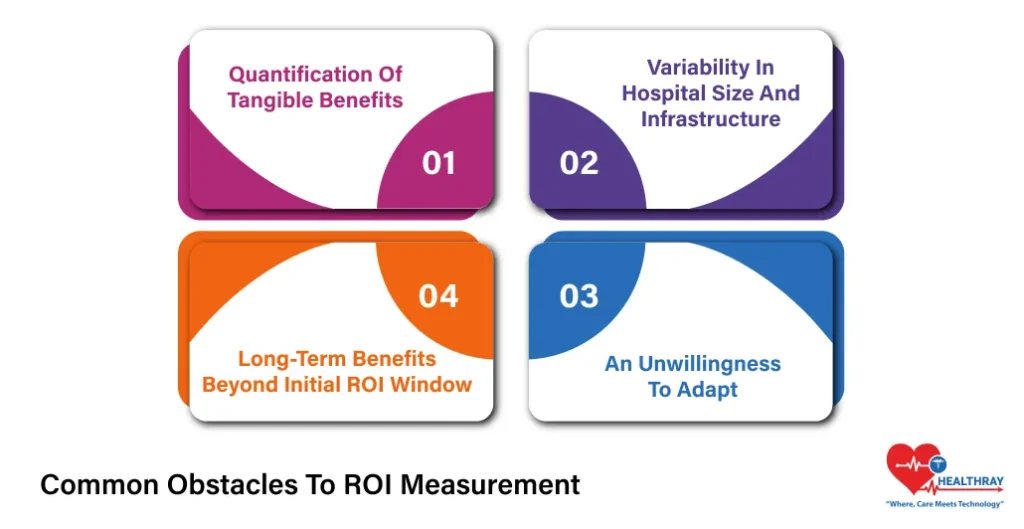
Let’s check out:
Quantification of Tangible Benefits
Have you ever wondered how to measure factors like patient satisfaction and care quality in numbers? Furthermore, this is the biggest challenge we face while estimating ERP ROI.
In other words, improved patient experience, faster service, and better staff coordination-like benefits are not visible in the direct balance sheet, but they create a tremendous impact in the long term. However, these intangible gains help hospitals establish strong reputations and patient trust.
Variability in Hospital Size and Infrastructure
Every hospital size, speciality and existing infrastructure is different. Furthermore, it directly impacts ROI calculation. Also, cost and benefit ratio may vary for small hospitals, but in large hospitals complexity and integration challenges still exist.
Therefore, it is indispensable for hospitals to understand this variation and set realistic expectations. Additionally, in this way hospitals can conveniently measure the true impact of erp investment.
An Unwillingness to Adapt
Staff hesitation is a common challenge while implementing a new hospital erp in the system. Further, if doctors, nurses and admin teams take considerable time to adapt to the new process, then expected productivity and efficiency gains take a longer time to accomplish.
Moreover, with training, clear communication, or gradual adoption strategies, Hospitals can minimize the resistance. Also, it helps them achieve the full effectiveness of the HMS system.
Long-Term Benefits Beyond Initial ROI Window
Sometimes the true impacts of ERP are not clearly visible. Further, in the initial 6-12 months, you only discover short-term savings and efficacy gain under ROI measurement. Additionally, long-term benefits such as sustained cost reduction, staff productivity improvement, and patient loyalty create a significant impact on hospital overall performance and revenue with time. Moreover, it is crucial to take into account both the ROI’s immediate and long-term benefits.
Best Practices To Maximise ROI
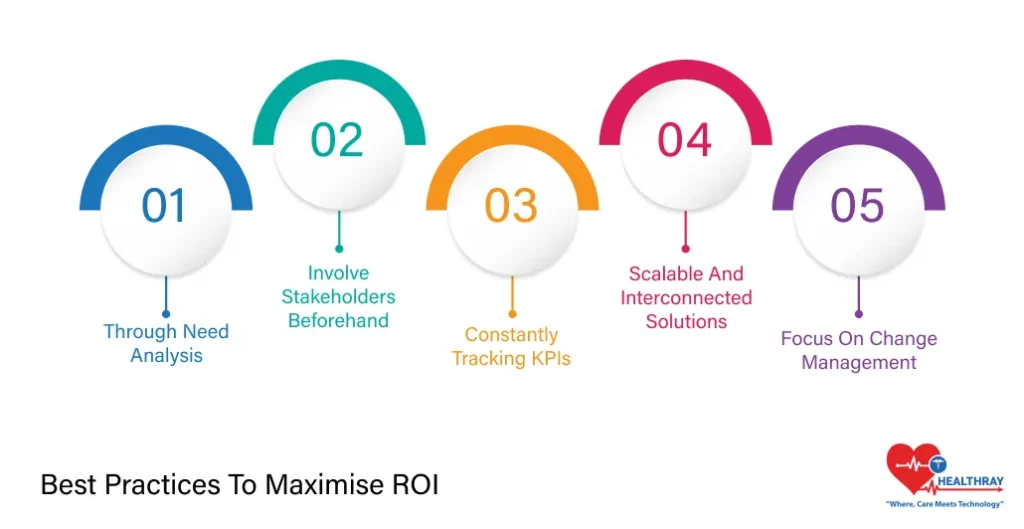
Let’s check out:
1. Through need analysis: Firstly, you need to understand the real requirements of your hospitals and then choos erp software that perfectly aligns with your needs.
2. Involve stakeholders beforehand: Engage doctors, nurses and admin teams in the initial stage and provide them with a complete training program.
3. Constantly tracking KPIs: After implementation of the best hospital software solutions, hospitals should regularly track performance metrics and make the process fine-tuned.
4. Scalable and interconnected solutions: It is imperative for healthcare organizations to choose erp software that can easily scale and integrate with future growth.
5. Focus on change management: It is crucial for hospitals to adjust staff resistance and encourage adoption to leverage the full power of the clinical erp system.
Conclusion
Measuring the ROI of hospital ERP software in India involves a comprehensive evaluation that includes cost savings, revenue optimization, productivity enhancements, compliance adherence, and strategic data usage. Furthermore, by taking a methodical approach to evaluation and deployment, healthcare providers can invest in ERP systems with confidence and reap significant operational and financial rewards that promote patient care excellence and long-term growth.
I hope the above blog provides you useful insights on how to measure the ROI of hospital erp software and how it directly impacts cost savings, revenue growth, staff productivity, regulatory compliance, or patient satisfaction.
